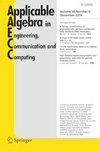伽罗瓦环标准模型的注释
IF 0.6
4区 工程技术
Q4 COMPUTER SCIENCE, INTERDISCIPLINARY APPLICATIONS
Applicable Algebra in Engineering Communication and Computing
Pub Date : 2023-06-22
DOI:10.1007/s00200-023-00612-8
引用次数: 0
摘要
在这项工作中,我们基于其残差场的标准模型提出了伽罗瓦环的标准模型,即以\({\mathbb Z}_{p^r}\)开头的伽罗瓦环序列,该序列包含具有该特征环的所有伽罗瓦环,并且有一个算法产生该序列的每个成员,其输入是所需环的大小。本文章由计算机程序翻译,如有差异,请以英文原文为准。
A note on a standard model for Galois rings
In this work we present a standard model for Galois rings based on the standard model of their residual fields, that is, a a sequence of Galois rings starting with \({\mathbb Z}_{p^r}\) that coves all the Galois rings with that characteristic ring and such that there is an algorithm producing each member of the sequence whose input is the size of the required ring.
求助全文
通过发布文献求助,成功后即可免费获取论文全文。
去求助
来源期刊
CiteScore
2.90
自引率
14.30%
发文量
48
审稿时长
>12 weeks
期刊介绍:
Algebra is a common language for many scientific domains. In developing this language mathematicians prove theorems and design methods which demonstrate the applicability of algebra. Using this language scientists in many fields find algebra indispensable to create methods, techniques and tools to solve their specific problems.
Applicable Algebra in Engineering, Communication and Computing will publish mathematically rigorous, original research papers reporting on algebraic methods and techniques relevant to all domains concerned with computers, intelligent systems and communications. Its scope includes, but is not limited to, vision, robotics, system design, fault tolerance and dependability of systems, VLSI technology, signal processing, signal theory, coding, error control techniques, cryptography, protocol specification, networks, software engineering, arithmetics, algorithms, complexity, computer algebra, programming languages, logic and functional programming, algebraic specification, term rewriting systems, theorem proving, graphics, modeling, knowledge engineering, expert systems, and artificial intelligence methodology.
Purely theoretical papers will not primarily be sought, but papers dealing with problems in such domains as commutative or non-commutative algebra, group theory, field theory, or real algebraic geometry, which are of interest for applications in the above mentioned fields are relevant for this journal.
On the practical side, technology and know-how transfer papers from engineering which either stimulate or illustrate research in applicable algebra are within the scope of the journal.

 求助内容:
求助内容: 应助结果提醒方式:
应助结果提醒方式:


